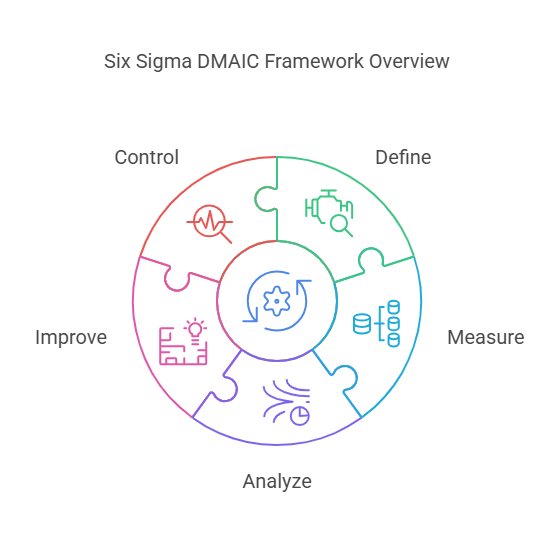Six Sigma Tools for DMAIC Phases

Six Sigma is a systematic technique that uses the DMAIC framework (Define, Measure, Analyze, Improve, and Control) to solve issues and improve processes. Each step of DMAIC employs distinct tools to help teams through issue identification, analysis, solution execution, and process management.
The key tools used in each phase of DMAIC:
1. Define Phase
In the Define phase, problems & clear objectives have to be identified. These tools help to zoom in on the scope of the project and determine what we want.
· Project Charter: This tool defines the problem, objectives, scope, team responsibilities, and project deadline.
· SIPOC Diagram: A high-level map that depicts suppliers, inputs, processes, outputs, and customers.
· Voice of the Customer: Captures consumer input to help identify essential requirements.
2. Measure Phase
Measure phase: Gathering data to determine baseline process performance. A Six Sigma project should work only if the data are accurate.
· Process Mapping: A visual depiction of the workflow is used to identify regions for data gathering.
· Data Collection Plan: A high-level map showing suppliers, inputs, processes, outputs, and consumers.
· Control Charts: Used to track process variations throughout time.
3. Analyze Phase
In this phase, data is analyzed to find out "why" this is happening. The tools that are applied in this function aim to diagnose problems with the process.
· Fishbone Diagram: Aids in determining probable sources of the problem.
· Pareto Chart: Identifies the most important variables leading to the situation.
· Hypothesis Testing: Tests assumptions to validate root causes.
4. Improve Phase
The Improve phase will develop and put into practice solutions for the root causes discovered in the Analyze phase.
· Brainstorming: Generates ideas for potential solutions.
· Design of Experiments: To identify the best answer, several elements are tested at the same time.
· Kaizen: A continuous improvement method based on modest, incremental adjustments.
5. Control Phase
The last phase sustains the changes as planned. The tools you use in this phase help you have control over improved processes, and persevere.
· Control Plan: Documents how the process will be monitored.
· Standard Operating Procedures: Ensure consistency in process execution.
· Statistical Process Control: Control charts are used to monitor the stability of processes.
Want to learn more?
Read the full blog on mastering Six Sigma tools for every phase of DMAIC.
What's Your Reaction?
















.jpg)


